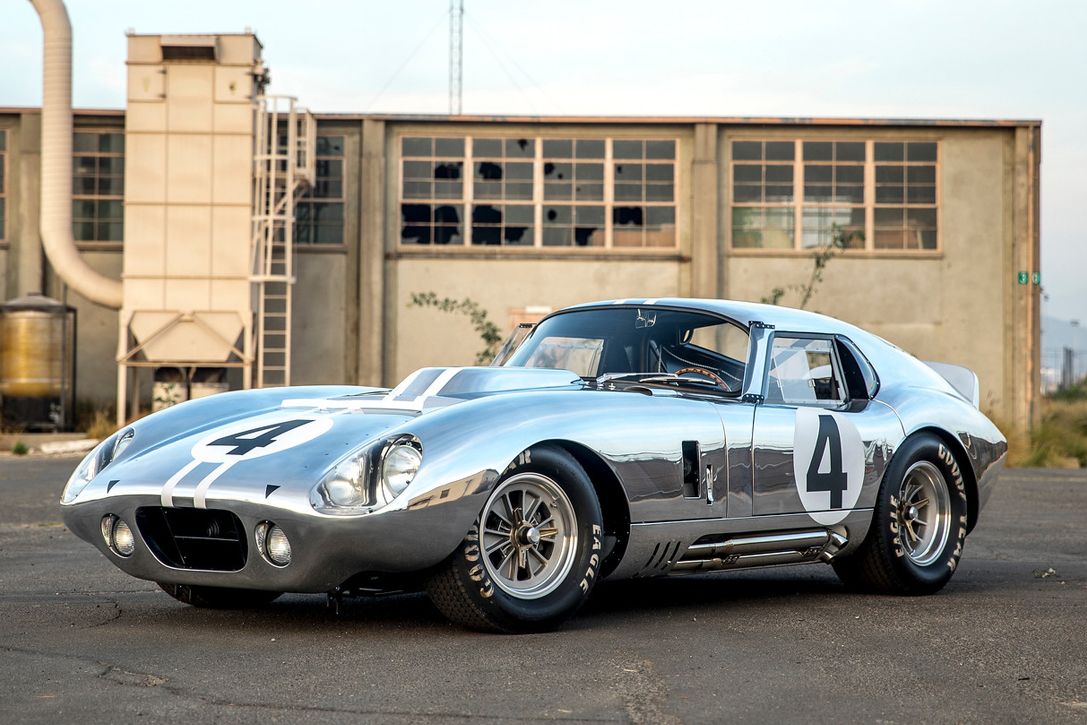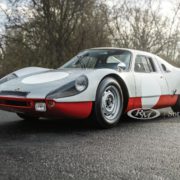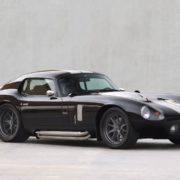The truth behind Shelby’s 1964 “secret weapon” Cobra Daytona Coupe
Like the gnarled reflections in the polished aluminum skin of this faithful recreation of the legendary race car, the tale of Shelby Cobra Daytona Coupe, chassis number CSX2286, became distorted over the last 55 years.
The truth behind Shelby’s 1964 “secret weapon” Cobra Daytona Coupe
As the story goes, the truck carrying CSX2286, the one-off Daytona Coupe built special for the 1964 24 Hours of Le Mans race, was involved in an accident on the way to the track. Carroll Shelby’s “secret weapon,” as the car would become known, was badly damaged and would not be able to race. According to the legend, the car was powered by an iron-block 427 with aluminum cylinder heads, just like the one the NASCAR boys had been running, and had been tested at Riverside.
In reality, the car was never finished. Despite the best efforts of John Ohlsen, one of Shelby’s trusted fabricators, CSX2286 was still missing major components in June 1964 and wasn’t ready to race. Despite the “story,” it was never put on a truck headed for Le Mans. Instead it remained under construction in a dark and dusty corner of Carrozzeria Grand Sport, an Italian body shop in Modena often used by Shelby.

“I think this story was invented by Shelby as an answer to why it never arrived in France for the race,” says Peter Brock, who designed the Cobra Daytona Coupe for Shelby in 1964. “It couldn’t have, as it was never completed and never ran. Since some people knew of Shelby’s plan to embarrass Ferrari with a prototype Daytona Coupe at Le Mans and it never showed, he had the story released that it had been crashed on the way to France.”
Months earlier, Shelby asked Ohlsen to yank the coupe’s 289 small-block, lengthen its chassis three inches and install an all-aluminum 427. He wanted a big-block to take on Ferrari in the Prototype Class. “The idea was that it would have the power of a big block with the lightweight of the 289,” Brock says.
Ohlsen modified the chassis at Shelby’s shop in Venice, California, and then shipped the car to Italy where he would oversee the body modifications and install the larger engine. Only Ford wouldn’t make Shelby an aluminum 427. “They said the bore spacing and thin walls of the block would cause overheating,” says Brock, who is now 82. “Instead, they sent us an aluminum 390 block, which Ohlsen installed.”
Unfortunately, time ran out. “The car was maybe 70-percent completed,” Brock says. “He was waiting on a long list of parts from Ford, including a clutch.” Shelby must have been disappointed. With more than 500 horsepower and weighing just 2200 pounds, the sleek, aerodynamic coupe would have been the fastest car on the three-mile long Mulsanne Straight that year. “We were running 197 mph in the 289 car,” Brock says. “So it would have easily passed 200 mph.”
Enzo must have had a laugh when he heard of his rival’s misfortune, and his team did win big that year, with Ferraris taking all three podium spots. But Shelby’s crew was a scrappy bunch, and a small-block Daytona Coupe, CSX229—with Ohlsen as crew chief and driven by Bob Bondurant and Dan Gurney—finished fourth, winning the GT class over Enzo’s GTOs.
After Le Mans, Ohlsen hoped to get the car ready for the final race of the season at Monza. “We even started calling it ‘The Monza Coupe,’ as opposed to the Daytona Coupe,” Brock says with a laugh. But factions inside Ford didn’t want the car competing with the company’s new GT40 and the parts never arrived.

Incomplete, CSX2286 was finally shipped back to California, where it was returned to its original short wheelbase, small-block configuration. It was then raced, only once, competing at Le Mans the following year, driven by Gurney and Jerry Grant. Due to clutch trouble it failed to finish.
In 1981, the car was tested by Car and Driver. With its small-block engine, the Daytona hit 60 mph in 4.4 seconds, 100 mph in a just 10.5 seconds, and tore through the quarter in 12.7 seconds at 111 mph.
Today, the storied blue Cobra Coupe, one of only six ever built, survives in the collection of Rob Walton, heir to the Walmart fortune. “That car is worth more than $15,000,000,” says Lance Stander, CEO of Shelby Legendary Cars. “Our car only costs half a million.”
Stander is in the replica Cobra business. The native of South Africa has owned Superformance for 13 years and Shelby Legendary Cars for about 12 months (after changing the company name from Hillbank Motor Corporation), and a $495,000 recreation of Shelby’s 1964 big-block-powered Cobra Daytona Coupe is one of his newest and most expensive products.
The guy is a walking encyclopedia on the subject, from the cars to the drivers of the era, and he’s excited that his cars will appear in the upcoming Ford vs. Ferrari movie, which was filmed with Matt Damon as Shelby and Christian Bale as his driver Ken Miles.
“The movie should come out next summer,” he says with a smile. “We loaned a few Superformance Cobras to the production, which they wrapped multiple times so they looked like the old race cars. They shot a bunch of scenes out at Willow Springs Raceway, which is where Shelby did a lot of testing back then.”
The first of just six to be built, the “Secret Weapon” replica was completed about a year ago and given the chassis number CSX2603, making it the first in the CSX2000 Series since the 1960s. It was then quickly sold to Craig Hansen of Des Moines, Iowa. “Craig buys one of everything we do,” Stander says. “He’s bought about $3.5 million in cars from us in the last three and a half years.”
Hansen, however, never drives the car. It lives at Stander’s facility along with several others that belong to him. “The kind of owners that buy these are just buying them for show to look pretty,” Stander says while opening the coupe’s polished aluminum door. “Not to drive. Maybe just to a cars and coffee.”
I poke my nose into the Coupe’s stark interior. The odometer reads 21 miles. Stander can see the shock and disappointment on my face. To buy this car and never drive it does seem crazy. “Trust me, you don’t want to drive this car on the street,” he says. “It’s too hot. Too small inside.”
Climbing behind the wheel, I can see his point. I don’t really fit in the car. My left shoulder is pinned against the door and the sliding plexiglass window is just an inch or so from my face. Hard and flat, the seat is fixed in position up against the left rear wheel well and my right knee is jammed into the sheetmetal of the dash. The shifter is too far away, and the pedals, which require significant muscle to operate, are too close together. Radically offset, the glossy wood steering wheel is aimed at my right shoulder. There are no soft surfaces. The ceiling is raw aluminum and my word’s echo inside the cabin like I’m sitting in a coffee can.
The men that raced these cars had guts. Visibility is horrible in all directions and the spindly-looking roll bar is formed from 1.5-inch tubing. There’s zero side protection, the doors are hollow and seem to weigh just a few ounces. “That’s exactly how they were,” Stander says. “The whole car is just as it would have been in 1964, from its FIA legal Girling disc brakes to its Toploader four-speed to its hand formed aluminum body.”
Shaped at Thomas Kirkham’s place in Utah, the car’s skin, like the rest of the machine, is a work of art and an exacting reproduction of the original. Lift the enormous clamshell hood and the welded seams are revealed on its underside, just as it would have been in 1964. Although Hansen’s is polished like a Tiffany tea set and wears number 4 and a couple of white stripes, Stander will paint yours any way you’d like.

The truth behind Shelby’s 1964 “secret weapon” Cobra Daytona Coupe
Also unique to the “secret weapon” is a large hood scoop to clear the big FE Ford’s four downdraft Webers. The scoop is open in the rear, and from the driver’s seat, with the hood down, I can clearly see the carbs. Also in sight a single small windshield wiper and yards of polished aluminum. The Daytona’s hood seems to go on for city block.
Fifty-five years ago Ohlsen pushed the coupe’s front wheels forward, stretching the race car’s wheelbase to 93 inches. Stander and his crew have done the same, recreating the coupes chassis in the same spec of round steel tubing and square stock as Shelby. And remember, the Daytona Coupes were based on 289 Cobras, so they had transverse leaf springs front and rear. Shelby finally switched to coil overs for the 427 Cobra roadsters. The control arms and the differential, with 3.54 gears and an oil cooler, are aluminum.
Although visually correct, the Shelby’s engine is the least authentic part of the car, measuring 468 cubic inches. Like the original’s 390, it features an aluminum block, and the headers are just like they were in 1964, hand welded to perfection, dumping side-pipe style under the doors. There’s also an aluminum radiator and an oil cooler. It’s a wet sump engine, but the oil filter is remote.
With a twist of the key, the big-block thunders to life, sending a violent shiver through the Daytona. Supplied by the Shelby Engine Company in Windsor, California, the big Ford packs a hydraulic roller cam, steel rocker arms with roller tips, a steel crank, forged rods, and a heady compression ratio. The company sells a similar crate engine with a Holley four-barrel for $28,299.99 it rates at 550 hp and 580 lb-ft of torque.









Leave a Reply
Want to join the discussion?Feel free to contribute!